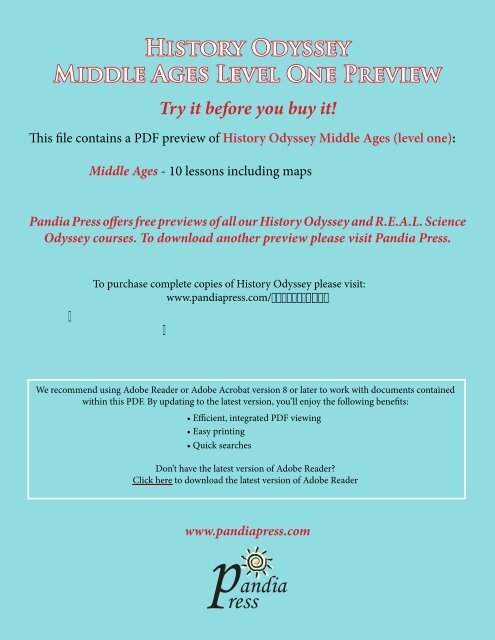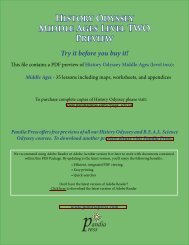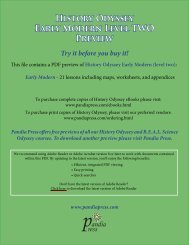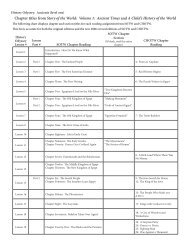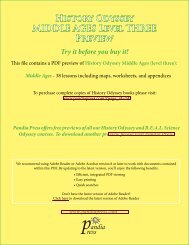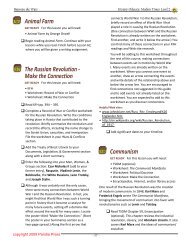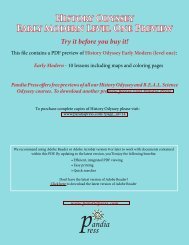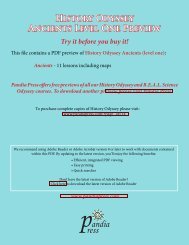History Odyssey - Middle Ages (level one) eBook ... - Pandia Press
History Odyssey - Middle Ages (level one) eBook ... - Pandia Press
History Odyssey - Middle Ages (level one) eBook ... - Pandia Press
- No tags were found...
You also want an ePaper? Increase the reach of your titles
YUMPU automatically turns print PDFs into web optimized ePapers that Google loves.
<strong>History</strong> <strong>Odyssey</strong><strong>Middle</strong> <strong>Ages</strong> Level One PreviewTry it before you buy it!This file contains a PDF preview of <strong>History</strong> <strong>Odyssey</strong> <strong>Middle</strong> <strong>Ages</strong> (<strong>level</strong> <strong>one</strong>):<strong>Middle</strong> <strong>Ages</strong> - 10 lessons including maps<strong>Pandia</strong> <strong>Press</strong> offers free previews of all our <strong>History</strong> <strong>Odyssey</strong> and R.E.A.L. Science<strong>Odyssey</strong> courses. To download another preview please visit <strong>Pandia</strong> <strong>Press</strong>.To purchase complete copies of <strong>History</strong> <strong>Odyssey</strong> please visit:www.pandiapress.com/We recommend using Adobe Reader or Adobe Acrobat version 8 or later to work with documents containedwithin this PDF. By updating to the latest version, you’ll enjoy the following benefits:• Efficient, integrated PDF viewing• Easy printing• Quick searchesDon’t have the latest version of Adobe Reader?Click here to download the latest version of Adobe Readerwww.pandiapress.compandiaress
HISTORY ODYSSEYMIDDLE AGESPREVIEWAN ACTIVITY-BASEDSTUDY GUIDE COMBININGHISTORYGEOGRAPHYLITERATUREWRITTEN BYCATHY WHITFIELDLEVEL ONE
<strong>History</strong> <strong>Odyssey</strong><strong>Middle</strong> <strong>Ages</strong><strong>level</strong> <strong>one</strong>Cathy Whitfield<strong>Pandia</strong> <strong>Press</strong>
<strong>Pandia</strong> <strong>Press</strong><strong>History</strong> <strong>Odyssey</strong>Copyright ©2006, 2009 <strong>Pandia</strong> <strong>Press</strong>All Rights ReservedWithout limiting the rights under copyright reserved above, no part of this publication may bereproduced, stored in or introduced into a retrieval system, or transmitted, in any form, nor by anymeans (electronic, mechanical, photocopying, recording, or otherwise), without the prior writtenpermission of <strong>Pandia</strong> <strong>Press</strong>. The purchaser of this study guide may photocopy maps and coloringpages for use with his or her own children. Copying for group, co-op, classroom, or school use isprohibited. Contact <strong>Pandia</strong> <strong>Press</strong> for information about group and school licensing.ISBN: 978-0-9766057-7-5Published by<strong>Pandia</strong> <strong>Press</strong>Mount Dora, FLVisit www.pandiapress.com for ordering information and sample pages of <strong>Pandia</strong> <strong>Press</strong> publications.- 2 -
<strong>Middle</strong> <strong>Ages</strong>Table of ContentsLevel 1How to Use This Guide .......................................................................................................... 4Suggested Weekly Schedule ................................................................................................... 8Lesson 1: Overview of the Medieval World ........................................................................ 11Lesson 2: The Byzantines ..................................................................................................... 12Lesson 3: Charlemagne ........................................................................................................ 13Lesson 4: Monks of the Christian Church ......................................................................... 15Lesson 5: Islam ..................................................................................................................... 17Lesson 6: Arabs .................................................................................................................... 19Lesson 7: Vikings .................................................................................................................. 20Lesson 8: Danes ................................................................................................................... 22Lesson 9: Holy Roman Empire ............................................................................................. 23Lesson 10: Normans ............................................................................................................ 24Lesson 11: 100 Years’ War and the Black Death .................................................................. 25Lesson 12: The Feudal System ............................................................................................. 27Lesson 13: Knights ............................................................................................................... 28Lesson 14: Castles ................................................................................................................ 30Lesson 15: Medieval Villages and Towns ............................................................................. 32Lesson 16: The Christian Church .......................................................................................... 33Lesson 17: Medieval Architecture ........................................................................................ 34Lesson 18: Pilgrimages and The Crusades ............................................................................ 35Lesson 19: Richard the Lionhearted and Robin Hood .......................................................... 36Lesson 20: Celts .................................................................................................................... 37Lesson 21: Burgundians and Habsburgs............................................................................... 38Lesson 22: Wars of the Roses ............................................................................................... 38Lesson 23: Mongols ............................................................................................................. 39Lesson 24: Eastern Europe ................................................................................................... 40Lesson 25: Russians .............................................................................................................. 41Lesson 26: The Moors in Spain .................... ....................................................................... 42Lesson 27: Africa ................................................................................................................... 43Lesson 28: India ................................................................................................................... 45Lesson 29: Southeast Asia .................................................................................................... 46Lesson 30: China .................................................................................................................. 48Lesson 31: Japan .................................................................................................................. 49Lesson 32: Explorers ............................................................................................................ 51Lesson 33: Pacific Ocean Islands .......................................................................................... 52Lesson 34: Native North Americans .................................................................................... 53Lesson 35: Central and South Americans ............................................................................... 56Lesson 36: Turks and Ottomans ........................................................................................... 61Lesson 37: The Start of the Renaissance .............................................................................. 62Lesson 38: More World Exploration ..................................................................................... 64Lesson 39: Moguls (Mughals) .............................................................................................. 66Lesson 40: The Reformation and Counter-Reformation ....................................................... 67Lesson 41: The Age of Elizabeth .......................................................................................... 68Lesson 42: William Shakespeare .......................................................................................... 71Lesson 43: <strong>Middle</strong> <strong>Ages</strong> <strong>History</strong> Keepsake Book .................................................................. 72- 3 -
<strong>Pandia</strong> <strong>Press</strong>How to Use This Guide<strong>History</strong> <strong>Odyssey</strong>Dear Parents and Teachers,Thank you for purchasing this <strong>History</strong> <strong>Odyssey</strong> study guide. If you have used <strong>History</strong> <strong>Odyssey</strong> in the past,then this is probably your second year taking this journey with your child. You are already familiar with aclassical approach to history and know your child will be spending the next school year immersed in thewonderful story of the <strong>Middle</strong> <strong>Ages</strong>. If this is your first time using <strong>History</strong> <strong>Odyssey</strong>, take the time to readthrough these introductory pages, gather materials and work out a schedule based on your child’s abilities.<strong>History</strong> <strong>Odyssey</strong> provides the structure and framework for using and organizing many of the best resourcesavailable for the study of humankind. This is not a textbook approach! If you or your child would rather afill-in-the-blanks workbook approach to history, then there are plenty of those curricula available. <strong>History</strong><strong>Odyssey</strong>’s unique approach for this age group is <strong>one</strong> that encompasses literature, activities, and geography.As your child progresses through this guide, he or she will be learning about <strong>Middle</strong> <strong>Ages</strong> history throughreading many of the best books written about this time period. Your child will be learning geography andbe engaged in exciting activities. <strong>History</strong> <strong>Odyssey</strong> presents history in a way that is exciting and memorable.Most parents and teachers find themselves wishing they had been taught history this way. So don’t besurprised if you find yourself learning and having fun right along with your child or student!Adapting for Different LevelsThese lesson plans are written for a student who is in the grammar stage of a classical education orin the first, second, third, or fourth grade (approximately 6 to 10 years old). That is a big span. Therecan a tremendous reading and comprehension skill discrepancy between a typical first and fourthgrade student. These plans have been carefully formulated to provide material to meet the needs ofall grammar-stage students no matter what their <strong>level</strong> or ability. Here are some further suggestions foradapting these plans for students at either end of the spectrum:Advanced Level (independent reader) -☑☑ Independently read books or read aloud to the group☑☑ Heavy focus on map work☑☑ Complete several activities per lesson☑☑ Add resources (especially whole books and classic literature)☑☑ <strong>History</strong> lessons three times per week (using the third lesson for further research or independentreading)☑☑Outline lessons or write summariesBeginning Level (not reading independently) -☑☑ Read books to child☑☑ Less focus on map work☑☑ More focus on coloring and drawing activities☑☑ Complete only <strong>one</strong> activity per lesson☑☑ <strong>History</strong> lessons <strong>one</strong> or two times per week☑☑ Have child copy or dictate summary sentences and dictionary words- 4 -
<strong>Middle</strong> <strong>Ages</strong> Level 1How to Use This GuideSequenceIn a classical education, history is studied chronologically. Ideally, a student will study the entirehistory of humankind over a four-year period three separate times, each time building on their knowledge.1st grade, 5th grade, and 9th grade -2nd grade, 6th grade, and 10th grade -3rd grade, 7th grade, and 11th grade -4th grade, 8th grade, and 12th grade -Ancient <strong>History</strong>The <strong>Middle</strong> <strong>Ages</strong>Early ModernModern <strong>History</strong>However, it has been our experience that many students are unable to follow this schedule exactlyfrom first through twelfth grade. Don’t worry if your child or student has to miss a period of history in<strong>one</strong> or more of the stages of education. They have three times to learn it! What is important is thatstudents are building on their knowledge in a sequential way and enjoying history.Required ResourcesMain Reference Spine: The Usborne Internet-Linked Encyclopedia of World <strong>History</strong>Optional Additional Reference Spine: A Child’s <strong>History</strong> of the World by V.M. HillyerBooks and Resources for the <strong>Middle</strong> <strong>Ages</strong>:Story of the World, Volume 2: The <strong>Middle</strong> <strong>Ages</strong> by Susan Wise Bauer (Peace Hill <strong>Press</strong>)<strong>History</strong> Pockets: Native Americans (Evan-Moor)Days of Knights and Damsels by Laurie Carlson (Chicago Review <strong>Press</strong>)A Coloring Book of the <strong>Middle</strong> <strong>Ages</strong> (Bellerophon)Knights of the Round Table by Gwen Gross (Random House)Meet Christopher Columbus by James T. de Kay (Random House)Shakespeare for Children audio CD by Jim Weiss (Greathall Productions)Additional Resources and ActivitiesEach lesson contains an additional reading list to allow students to research a topic further and toprovide resources to meet the needs of students with varying abilities. Most can be found at yourlocal library. In addition to the required resources listed above, you will need a world map or atlas,a three-ring notebook or folder for each student to store his work, blank paper, simple art supplies,and a children’s dictionary. We recommend Webster’s New World Children’s Dictionary, but any gooddictionary will work. You will also want to have a three-hole punch and a camera handy.Copy WorkMost of the copy work in this study guide is from the dictionary. This will help your student learndictionary skills. You may also ask your student to summarize the lesson in his own words. Have yourstudent either write the summary, copy it, or dictate to you depending on his skill <strong>level</strong>. Copying sentenceshelps young children learn spelling, punctuation, and basic grammar. It will help prepare themfor writing their own sentences.- 5 -
<strong>Pandia</strong> <strong>Press</strong><strong>History</strong> NotebookHow to Use This Guide<strong>History</strong> <strong>Odyssey</strong>Your child will need a place to keep their written work, map work, history pockets, and coloring pageswhile completing this course. We recommend having a designated history folder or a three-ringbinder for this purpose. All collected work will be used to construct a <strong>Middle</strong> <strong>Ages</strong> Keepsake Book atthe end of the course.Activities: Projects, Coloring Pages, <strong>History</strong> Pockets Books, and MapsThe activities in this guide include coloring pages, activity projects, <strong>History</strong> Pockets books, and mapwork. These activities provide hands-on learning experiences.Maps - There are eighteen maps included in this course. The maps provide an opportunity to learn<strong>Middle</strong> <strong>Ages</strong> and modern-day world geography. Map work includes simple labeling, coloring, andcompleting map keys. Your child will need a detailed wall map or atlas to complete the maps. Whenlabeling and coloring maps use colored pencils or crayons. Markers tend to bleed through and blot outlabels.Projects: We tried to list many hands-on projects in this lesson plan with the intention that you willpick the <strong>one</strong>s that will most interest your student. Consequently, in many lessons there are more projectslisted than would be practical to do. Remember as you go along to take pictures of the projectsfor the Ancient <strong>History</strong> Keepsake Book in the final lesson.Coloring Pages: In most lessons you may have your student draw a picture or color the <strong>one</strong>(s) suggested.Allow your student to use a variety of media: crayons, colored pencils, markers and paints.The best way to incorporate the coloring pages is to have your child color the corresponding pagewhile you are reading aloud.LessonsIn each lesson you will do several of the following . . .☑☑ Reading from the Usborne Internet-Linked Encyclopedia of World <strong>History</strong> (hereafter abbreviatedUILE)☑☑Reading from The Story of the World, Volume 2 (hereafter abbreviated SOTW)☑☑Reading from A Child’s <strong>History</strong> of the World (hereafter abbreviated CHOTW)☑☑ Writing activities☑☑ Projects☑☑ Coloring pages☑☑ Labeling and coloring the map and looking at a globe, atlas, or wall map☑☑ Creating a pocket from the <strong>History</strong> Pocket book☑☑ Reading from the suggested book list or finding additional books on your ownThese plans are based on a full school year of history studies. Each lesson is intended to takeabout a week to complete. In some lessons you will find an abundance of information, and you willwant to take two or more weeks for these lessons. This study guide is written to include as much- 6 -
<strong>Middle</strong> <strong>Ages</strong> Level 1How to Use This Guideinformation as possible. Since every family has a different schooling style, these lesson plans are designedto be as flexible as possible. You will not complete every project and book listed. When a conceptinterests your child, use the book list or look up that topic at your library. Bring the book list fromthe next two lessons with you to the library to avoid having to scramble for resources. Reading at least<strong>one</strong> additional book from the book list per lesson is recommended; more if your child is interested. Atthe end of this study guide, you will be assisting your child in compiling her work into a <strong>Middle</strong> <strong>Ages</strong>Keepsake Book. It will be a wonderful keepsake. Your student can show family and friends everythinglearned about the <strong>Middle</strong> <strong>Ages</strong>.Helpful HintsDepending on your child’s reading <strong>level</strong>, you can either read to him, have him read aloud to you, orhave him read independently. If your child is a mover, try having him color a coloring page while youread. Each child is different; find what works best for yours. Remember, just because a child is movingdoes not mean he is not listening.Many lessons require gathering of project materials and making copies. The intention is thatyou will go over these a few days prior to the lesson to ensure you have all necessary materials. The<strong>History</strong> Pockets book requires that you copy several pages for each pocket. We suggest that you takethe book to a copy center and make all of the necessary copies at <strong>one</strong> time.You will notice that some lessons overlap in time period. You may also notice that SOTW, UILE, andCHOTW follow a somewhat different chronological order. Therefore, the reading assignments will bescattered throughout these books and do not always follow the order as presented in these books.You may want to flip back in SOTW or CHOTW if the chapter you are reading makes reference to theprevious <strong>one</strong>. (Generally only the first sentence or two refers to the previous chapter.)Begin collecting paper tubes, oatmeal boxes, cardboard boxes, cereal boxes, etc. These items willbe needed to make a castle in Lesson 14.- 7 -
<strong>Pandia</strong> <strong>Press</strong>Suggested Weekly Schedule<strong>History</strong> <strong>Odyssey</strong>Week Start Date Lesson Activities, Books, Supplies, & Preparation1 #1 Overview of the Medieval World2 #2 The Byzantines3 #3 Charlemagne4 #4 Monks of the Christian Church5 #5 Islam#6 Arabs6 #7 Vikings7 #8 Danes#9 Holy Roman Empire8 #10 Normans9 #11 100 Years’ War and the Black Death10 #12 The Feudal System11 #13 Knights12 #14 Castles13 #15 Medieval Villages and Towns14 #16 The Christian Church#17 Medieval Architecture15 #18 Pilgrimages and The Crusdaes16 #19 Richard the Lionhearted and RobinHood17 #20 Celts18 #21 Burgundians and Habsburgs#22 Wars of the Roses19 #23 Mongols#24 Eastern Europe- 8 -
<strong>Middle</strong> <strong>Ages</strong> Level 1Suggested Weekly ScheduleWeek Start Date Lesson Activities, Books, Supplies, & Preparation20 #25 Russians#26 The Moors in Spain21 #27 Africa22 #28 India#29 Southeast Asia23 #30 China24 #31 Japan25 #32 Explorers26 #33 Pacific Ocean Islands27 #34 Native North Americans - Parts 1 & 228 #34 Native North Americans - Parts 3 & 429 #35 Central and South America - Part 130 #35 Central and South America - Parts 2 & 331 #36 Turks and Ottomans32 #37 The Start of the Renaissance33#38 More World Expansion3435#39 Moguls (Mughals)#40 The Reformation and Counter-Reformation#41 The Age of Elizabeth#42 William Shakespeare36 #43 <strong>Middle</strong> <strong>Ages</strong> <strong>History</strong> Keepsake Book- 9 -
<strong>Pandia</strong> <strong>Press</strong>- 10 -
<strong>History</strong> <strong>Odyssey</strong>: <strong>Middle</strong> <strong>Ages</strong> Level 1Lesson 1 - Overview of the Medieval WorldDate:________________Prep for Lesson 1:☐☐Gather supplies needed for project(s) you plan on doing in Days of Knights and Damsels.Main Lesson:☐☐☐☐☐☐Read UILE pages 198-199. Discuss pictures as you read.Review Rome and the end of ancient times—read SOTW Chapter 1: The Glory That Was RomeUse a children’s dictionary and help your child look up and define Latin. Be sure to place this copy work inyour child’s history notebook.☐☐ Review or learn Roman numerals.☐☐Read pages 1-10 in Days of Knights and Damsels☐☐ Read CHOTW Chapter 41: Barbarians Meet the Champions of the WorldIf you have Internet access, don’t forget to use the Web site offered in UILE on pages 200-201 with eachlesson in this study guide. Once at the site, follow the directions on page 200, clicking on the Encyclopediaof World <strong>History</strong> link. This will bring you to a page where you can type in the page number (in UILE) you arestudying at the moment. Once you do this and click “Find Links,” you will be directed to a page with links andother useful information for the time and area you are studying.Additional Activities:Choose <strong>one</strong> or more of the following projects found in Days of Knights and Damsels:☐☐ Wig with Braids - page 11☐☐ Pocket & Alm<strong>one</strong>r - page 15☐☐ Shoes - page 20Poulaines - page 22☐☐Book List:Ezra’s Quest: Follow That Dog! By Rosalyn Schanzer (Doubleday Book for Young Readers, 1994)ISBN 0385322623 – Maze book reviewing <strong>Middle</strong> <strong>Ages</strong>.The <strong>Middle</strong> <strong>Ages</strong>: Investigate and Understand the <strong>Middle</strong> <strong>Ages</strong> by Sarah McNeill (Oxford University <strong>Press</strong>, 1998)ISBN 0195213947Turn of the Century by Ellen Jackson (Charles Burch, 1998) ISBN 088106369X – read from 1000-1600Favorite Medieval Tales by Mary Pope Osborne (Hyperion Books for Children, 2002) ISBN 0439141346The <strong>Middle</strong> <strong>Ages</strong> by Jane Shuter (Heinemann Library, 2000) ISBN 1575728869Investigating Medieval Times by Alison Henry (Trafalgar Square Publishing, 1997) ISBN 0707802261The <strong>Middle</strong> <strong>Ages</strong> by Peter Chrisp (Two-Can Publishing, 1997) ISBN 1587280698- 11 -
<strong>Pandia</strong> <strong>Press</strong>The Measly <strong>Middle</strong> <strong>Ages</strong> (Horrible <strong>History</strong> Series) by Terry Deary (Scholastic, 1998) ISBN 0590498487Highly recommended. Other books in this series are included in this study guide.Adventures in the <strong>Middle</strong> <strong>Ages</strong> (The Good Times Travel Agency Series) by Linda Bailey (Kids Can <strong>Press</strong>, 2000)ISBN 1550745409The <strong>Middle</strong> <strong>Ages</strong> by Maria Rius (Barrons Juveniles, 1988) ISBN 0812033868Time Trekkers: <strong>Middle</strong> <strong>Ages</strong> by Kate Needham (Copper Beech, 1996) ISBN 0761304819Lesson 2 - The ByzantinesDate:________________Prep for Lesson 2:☐☐Gather supplies needed for project(s) you plan on doing in Days of Knights and Damsels.Main Lesson:☐☐☐☐ Read UILE pages 202-203. Discuss pictures as you readUse a children’s dictionary and help your child look up and define just. Place this copy work inyour child’s history notebook.☐☐ On Map 1, “The Byzantine Empire,” help your child identify and label major bodies of water(Mediterranean Sea, Black Sea, and the Atlantic Ocean). Also label Spain, Greece, and Italy. Use UILE page202 to color the area of the Byzantine Empire at the start of Justinian’s reign (solid lines) green and thelands won by Justinian (dotted lines) orange. Complete the map key.Read SOTW Chapter 4: The Byzantine Empire.☐☐☐☐☐☐☐☐Read CHOTW Chapter 42: New Places – New Heroes.Color “A Byzantine Warrior” on page 4 in A Coloring Book of the <strong>Middle</strong> <strong>Ages</strong>.In SOTW, use <strong>one</strong> or more of the Codes of Justinian in Chapter 4 for copy work.Additional Activities:Choose <strong>one</strong> or more of the following projects found in Days of Knights and Damsels:☐☐ Lady’s Looking Glass - page 18☐☐ Buttons & Bracelets - page 30Porridge - page 49☐☐Book List:Byzantine Fashions by Tom Tierney (Dover, 2002) ISBN 0486419576Byzantine Paper Dolls by Tom Tierney (Dover, 2002) ISBN 0486420779The Byzantine Empire by Elsa Marston (Benchmark Books, 2002) ISBN 0761414959- 12 -
<strong>History</strong> <strong>Odyssey</strong>: <strong>Middle</strong> <strong>Ages</strong> Level 1Lesson 3 - CharlemagneDate:________________Prep for lesson 3:☐☐Gather supplies needed for project(s) you plan on doing in Days of Knights and Damsels.Main Lesson:☐☐☐☐ Read UILE pages 204 and 216. Discuss pictures as you readUse a children’s dictionary and help your child look up and define ordeal. Place this copy work inyour child’s history notebook.☐☐ Read SOTW Chapter 11: The Kingdom of the Franks.☐☐ Read CHOTW Chapter 47: Two Emperors, Two Empires.☐☐ Read SOTW Chapter 13: The Great Kings of France.☐☐ On Map 2, “The Empire of Charlemagne,” help your child identify and label the Mediterranean Sea and theAtlantic Ocean. Use UILE page 216 as a reference to shade—in any color—the empire of Charlemagne(within the dotted lines). Use the map in Chapter 13 of SOTW and your atlas to label Spain, England, Italy,Sicily, and the two islands to the west of Italy.☐☐☐☐☐☐Color <strong>one</strong> or both pages “Charlemagne” (8) and “Roland Blowing His Horn” (9) in A Coloring Book of the<strong>Middle</strong> <strong>Ages</strong>.Read Knights of the Round Table from the “Stepping St<strong>one</strong>s” series adapted by Gwen Gross.Have your child answer aloud and/or write the answers to these questions after they have finished readingeach chapter of the above book:Chapter 1: Why did Arthur first pull the sword from the st<strong>one</strong>? (Answer: To give it to Sir Kay because hehad forgotten his.)Chapter 2: How many chairs were around the Round Table? (Answer: 150)Chapter 3: What was the name of King Arthur’s sword? (Answer: Excalibur)Chapter 4: Sir Gawain made a promise to Lady Ragnell. This was a hard promise for him to keep. Have youever made a promise or agreed to do something that was hard for you? Explain.Chapter 5: When Linnett found out Gareth, “Big Hands,” was really a son of a king, how do you think shefelt about the way she had treated him? No matter who he was, how should she have treated him?Chapter 6: What do you think happened to King Arthur? You continue the story.Additional Activities:Choose <strong>one</strong> or more of the following projects found in Days of Knights and Damsels:☐☐ Cloak - page 23☐☐ Magic Wand - page 29☐☐ Cabbage Stew & Dumplings - page 50Fancy Writing: Calligraphy - page 108☐☐Book List:His Majesty’s Elephant by Judith Tarr (Jane Yolen Books, 1993) ISBN 0152007377 – Fictional read-aloud aboutCharlemagne’s daughter. Highly recommended.The Marvelous Blue Mouse by Christopher Manson (Henry Holt & Company, 1992) ISBN 0805016228 - An adorablestory about Emperor Charlemagne and a blue mouse.- 13 -
<strong>Pandia</strong> <strong>Press</strong>Princess Bianca and the Vandals: A Post Modern Tale of Two Kingdoms by Nick Licata (Fratri Gracci Publishing,2003) ISBN 0974327603Tales of King Arthur: Excalibur by Hudson Talbott (Books of Wonder, 1996) ISBN 0688133819 - A beautifullyillustrated series.Tales of King Arthur: King Arthur and the Round Table by Hudson Talbott (Books of Wonder, 1995)ISBN 0688113419Tales of King Arthur: Lancelot by Hudson Talbott (Books of Wonder, 1999) ISBN 0688148336Knights of the Kitchen Table by Jon Scieszka (Viking, 1991) ISBN 0670836222 - The boys are transported back toKing Arthur’s court (reading <strong>level</strong> ages 7-11).- 14 -
<strong>History</strong> <strong>Odyssey</strong>: <strong>Middle</strong> <strong>Ages</strong> Level 1Lesson 4 - Monks of the Christian ChurchDate:________________Prep for Lesson 4:☐☐Gather supplies needed for project(s) you plan on doing in Days of Knights and Damsels.Main Lesson:☐☐☐☐☐☐☐☐☐☐Read UILE pages 205 and 236-237. Discuss pictures as you readUse a children’s dictionary and help your child look up and define monk. Place this copy work inyour child’s history notebook.Read CHOTW Chapter 43: Being Good.Read SOTW Chapter 3: Christianity Comes to Britain.Color <strong>one</strong> or both pages, “A Monk Copying a Book” (6) and “Birds and Beasts” (7) in A Coloring Book of the<strong>Middle</strong> <strong>Ages</strong>.Additional Activities:Choose <strong>one</strong> or more of the following projects found in Days of Knights and Damsels:☐☐ Real Gingerbread- page 61☐☐ Scroll & Carrier - page 107☐☐ Decorate Some Notepaper - page 110Try a Triptych - page 132☐☐Book List:Marguerite Makes a Book by Bruce Robertson (J. Paul Getty Museum, 1999) ISBN 089236372X - Margueritehelps her father finish a manuscript in time.Bibles and Bestiaries: A Guide to Illuminated Manuscripts by Elizabeth B. Wilson (Farrar, Straus, and Giroux,1994) ISBN 0374306850 – Beautiful!Illuminations by Jonathan Hunt (Bradbury <strong>Press</strong>, 1989) ISBN 0027457702This book is made like an old, illustrated manuscript.Pascual and the Kitchen Angels by Tomie DePaola (G.P. Putnam’s Sons, 2004) ISBN 0399242147The Holy Twins: Benedict and Scholastica by Kathleen Norris (G. P. Putnam’s Sons, 2001) ISBN 0399234241The story of Saint Benedict.The Man Who Loved Books by Jean Fritz (G.P. Putnam and Sons, 1981) ISBN 0399207155The Monk (a movie) by Shlessinger Media, 2002The Abbot and I: As Told By Josie the Cat by Sarah E. Cowie (Conciliar <strong>Press</strong>, 2001) ISBN 188821225XColor Your Own Book of Kells by Marty Noble (Dover, 2002) ISBN 0486418650- 15 -
<strong>Pandia</strong> <strong>Press</strong>A Medieval Alphabet to Illuminate (Bellerophon Books, 1983) ISBN 0883880016The Sailor Who Captured the Sea: A Story of the Book of Kells by Deborah Nourse Lattimore (Harpercollins,1991) ISBN 0060237112Brother Bartholomew and the Apple Grove by Jan Cheripko (Boyds Mills <strong>Press</strong>, 2004) ISBN 1590780965A Medieval Monk by Giovanni Caselli (Peter Bedrick Books, 1986) ISBN 0872261050- 16 -
<strong>History</strong> <strong>Odyssey</strong>: <strong>Middle</strong> <strong>Ages</strong> Level 1Lesson 5 - IslamDate:________________Prep for Lesson 5:☐☐Gather supplies needed for project(s) you plan on doing in Days of Knights and Damsels.Main Lesson:☐☐☐☐ Read UILE pages 206 - 207. Discuss pictures as you read.Use a children’s dictionary and help your child look up and define mosque. Place this copy work in yourchild’s history notebook.☐☐ On Map 3, “The Islamic Empire,” use UILE page 207 as a reference to color the Islamic Empire tan (withinthe dotted lines). Ask “Can you find the Mecca on your map?” Circle it in red. Draw little people all overthe Islamic Empire, then draw dotted lines from those people to Mecca. This will show Muslims going onpilgrimages to their holy city. Complete the map key. Label as many bodies of water as you can.Read CHOTW Chapter 45: Muhammad and the Early Years.☐☐☐☐☐☐☐☐☐☐Read SOTW Chapter 6: The Rise of Islam.If using SOTW, you can use <strong>one</strong> or more of The Five Pillars found in Chapter 6 as copy work.Draw and color a picture about what was read about in this lesson. Hints: a mosque (remember that inIslam, no animals or people are allowed to be drawn on a mosque) or people on a pilgrimage.Why do Muslims try to go on a pilgrimage to Mecca at least once in their lifetime if they can afford it?[Answer: The Koran (also spelled Quran) says Allah commands them to go. Mecca (also called Makkah) isthe holy city of Islam.]Additional Activities:Choose <strong>one</strong> or more of the following projects found in Days of Knights and Damsels:☐☐ Life Mask - page 71Dolls - page 90☐☐Book List:Mosque by David Macaulay (Houghton Mifflin, 2003) ISBN 0618240349Muhammad of Mecca: Prophet of Islam by Elsa Marston (Franklin Watts, 2001) ISBN 0531203867 - Reading <strong>level</strong>is grade four or above. If you do not want to read aloud the whole book, just read select chapters. If you onlyread selections, at least read the introduction and chapters two, seven and eight.A 16th Century Mosque Inside Story by Fiona MacDonald and Mark Bergin (Peter Bedrick Books, 1994) ISBN087226310XMuslim Child: Understanding Islam through Stories and Poems by Rukhsana Khan (Albert Whitman & Company,1999) ISBN 0807553077 – Written by a Muslim woman trying to help young people understand Muslim children.Muslim Mosque: Places of Worship by Angela Wood (Gareth Stevens Publishing, 2000) ISBN 0836826094The Hundredth Name by Shulamith Levey Oppenheim (Boyds Mills <strong>Press</strong>, 1995) ISBN 1563971836- 17 -
<strong>Pandia</strong> <strong>Press</strong>Mu h amm a d by Demi (Margaret K. McElderry Books, 2003) ISBN 0689852649 - Introduces Muhammad and thebasic tenets of the Islamic faith. Other books by Demi are also recommended.And the Earth Trembled: The Creation of Adam and Eve by Shulamith Levey Oppenheim (Harcourt Brace &Company, 1996) ISBN 0152000259 - An Islamic version of the story of the creation of Adam and Eve.Stories of the Caliphs: The Early Rulers of Islam by Denys Johnson-Davies (Amideast, 1997) ISBN 9775325412Mecca and Other Islamic Holy Places by Mandy Ross (Raintree, 2003) ISBN 0739860801What I Believe by Alan Brown and Andrew Langley (Millbrook <strong>Press</strong>, 1999) ISBN 0761315012 - Read aboutIslam. You will be reading this book again in later lessons.- 18 -
<strong>History</strong> <strong>Odyssey</strong>: <strong>Middle</strong> <strong>Ages</strong> Level 1Lesson 6 - ArabsDate:________________Prep for Lesson 6:☐☐Gather supplies needed for project(s) you plan on doing in Days of Knights and Damsels.Main Lesson:☐☐☐☐☐☐☐☐☐☐Read UILE pages 208-209. Discuss pictures as you readUse a children’s dictionary and help your child look up and define translate. Place this copy work in yourchild’s history notebook.Read CHOTW Chapter 46: Arabian Days.Read SOTW Chapter 7: Islam Becomes an Empire.Have your child try to write the Arabic numbers as shown in UILE on page 209 or in the book Count YourWay Through the Arab World by Jim Haskins (listed below). Place this copy work in your child’s historynotebook.Additional Activities:Choose <strong>one</strong> or more of the following projects found in Days of Knights and Damsels:☐☐ Alquerque - page 74☐☐ Draughts - page 76☐☐ Doll House - page 95A Little Geometry - page 123☐☐Book List:Sinbad From the Tales of the Thousand and One Nights by Ludmila Zeman (Tundra Books, 1999)ISBN 0887764606Count Your Way Through the Arab World by Jim Haskins (Carolrhoda Books, 1987) ISBN 0876143044Highly recommended.Ali Baba and the Forty Thieves by Walter McVitty (Harry N. Abrams, Inc., 1988) ISBN 0810918889 - One of thetales from A Thousand and One Arabian Nights.The Rose’s Smile: Farizad of the Arabian Nights by David Kherdian (Henry Holt and Company, 1997)ISBN 0805039120Aladdin and Other Tales From the Arabian Nights (Classic Readers Level 3) by Rosalind Kerven (DK, 2000) ISBN0789457008The House of Wisdom by Florence Parry Heide and Judith Heide Gilliland (DK Publishing, 1999)ISBN 0789425629The Arabs by Mokhtar Moktefi (Millbrook <strong>Press</strong>, 1992) ISBN 1562942018Stories from the Arab Past by Denys Johnson-Davies (Hoopoe Books, 1997) ISBN 9775325684- 19 -
<strong>Pandia</strong> <strong>Press</strong>Lesson 7 - VikingsDate:________________(Remember to collect boxes and paper tubes for Lesson 14)Prep for Lesson 7:☐☐Gather supplies needed for project(s) you plan on doing in Days of Knights and Damsels.Main Lesson:☐☐☐☐☐☐☐☐☐☐☐☐☐☐Read UILE pages 210-211. Discuss pictures as you read.Use a children’s dictionary and help your child look up and define saga. Place this copy work in your child’shistory notebook.Read CHOTW Chapter 49: The End of the World.Read UILE pages 212-213.On Map 4, “The Viking World,” label the Mediterranean Sea, the Atlantic Ocean, and the Black Sea. UseUILE page 212 as a reference to color Norway, Sweden and Denmark. (These are the Viking homelands.)Draw in red some of the routes the Vikings took while exploring the new world. Complete the map key.Help your child find and label Spain.Read SOTW Chapter 14: The Arrival of the Norsemen.Color page 10, “A Viking Ship,” in A Coloring Book of the <strong>Middle</strong> <strong>Ages</strong>.Additional Activities:Choose <strong>one</strong> or more of the following projects found in Days of Knights and Damsels:☐☐ Fox & Geese - page 78Glorious Goblet - page 161☐☐Book List:The Vikings Footsteps in Time by Ruth Thomson (Children’s <strong>Press</strong>, 1995) ISBN 0516080598 - Easy to make crafts.Yo, Vikings! by Judith Byron Schachner (Dutton Children’s Books, 2002) ISBN 0525468897Viking It and Liking It (The Time Warp Trio #12) by Jon Scieszka (Puffin Books, 2002) ISBN 0142400025Viking Ships at Sunrise (Magic Tree House #15) by Mary Pope Osborne (Random House, 1998) ISBN0679890610 – Reading <strong>level</strong> 2Adventures with the Vikings by Linda Bailey (Kids Can <strong>Press</strong>, 2001) ISBN 1550745441The Vikings by Jane Shuter (Heinemann Library, 2003) ISBN 1403400822Elfwyn’s Saga by David Wisniewski (Lothrop, Lee, and Shepard Books, 1990) ISBN 0688095895Vikings (Come and Discover My World) by Peter Chrisp (Two-Can Publishing, 2002) ISBN 158728071XGrowing Up in Viking Times by Dominic Tweddle (Troll Associations, 1994) ISBN 0816727252- 20 -
<strong>History</strong> <strong>Odyssey</strong>: <strong>Middle</strong> <strong>Ages</strong> Level 1You Wouldn’t Want to be a Viking Explorer! Voyages You’d Rather Not Make by Andrew Langley (Franklin Watts,2001) ISBN 0531162052How We Know About The Vikings by John and Louise James (Peter Bedrick Books, 1997) ISBN 0872265358The Saga of Erik the Viking by Terry J<strong>one</strong>s (Schocken Books, 1983) ISBN 080523876XAdventures with the Vikings (Good Times Travel Agency) by Linda Bailey (Kids Can <strong>Press</strong>, 2001)ISBN 1550745425Viking Times If You Were There by Antony Mason (Simon & Schuster Books for Young Readers, 1997)ISBN 0689811985 – Has a fold-out game board in the back of the book.The Vikings (Pictures of the Past) by Denise Allard (Gareth Stevens Publishing, 1997) ISBN 0836817176First Facts About the Vikings by Jacqueline Morley (Peter Bedrick Books, 1996) ISBN 0872264971Food & Feasts with the Vikings by Hazel Mary Martell (New Discovery Books, 1995) ISBN 0027263177Has recipes in the back of the book.Leif the Lucky by Ingri D’Aulaire (Beautiful Feet Books, 1994) ISBN 0964380307Before Columbus: The Leif Eriksson Expedition by Elizabeth Kimmel (Random House Books for Young Readers,2003) ISBN 0375813470The Vikings by Elizabeth Janeway (Random House Books for Young Readers, 1981) ISBN 0394848853What A Viking! by Mick Manning (R and S Books, 2000) ISBN 9129648831Story of the Vikings Coloring Book by A.G. Smith (Dover, 1988) ISBN 0486256537The Vicious Vikings (Horrible Histories Series) by Terry Deary (Scholastic, 1998) ISBN 0590498495Odin’s Family: Myths of the Vikings by Neil Philip (Orchard Books, 1996) ISBN 0531095312- 21 -
<strong>Pandia</strong> <strong>Press</strong>Lesson 8 - DanesDate:________________Prep for Lesson 8:☐☐Gather supplies needed for project(s) you plan on doing in Days of Knights and Damsels.Main Lesson:☐☐☐☐☐☐☐☐☐☐Read UILE pages 214-215. Discuss pictures as you readUse a children’s dictionary and help your child look up and define navy. Place this copy work in your child’shistory notebook.Read CHOTW Chapter 48: Getting a Start.Read SOTW Chapter 15: The First Kings of England – The Vikings Invade England and Alfred the Great.Draw and color a picture about what was read about in this lesson. (Hints: Anglo-Saxon helmet or anythingfrom the Dane village life.)Additional Activities:Choose <strong>one</strong> or more of the following projects found in Days of Knights and Damsels:☐☐ Pies & Tarts - page 52☐☐ 4 & 20 Blackbird Pie - page 56Blackbird Pie Puppet - page 58☐☐Book List:The Anglo-Saxon Household by Jean Ellenby (Cambridge University <strong>Press</strong>, 1986) ISBN 0521303796This book is out of print, but you might be able to find it at the library.The Anglo-Saxons British Museum Activity Books Series by John Reeve (Parkwest Publications, 1987)ISBN 0714105376The Smashing Saxons Horrible Histories Series by Terry Deary (Scholastic, 2004) ISBN 0439012716The Anglo-Saxons by Roger Coote (Thomson Learning, 1993) ISBN 1568470622Houses and Homes See Through <strong>History</strong> Series by Tim Wood (Viking, 1995) ISBN 0670867772Read the section on “Anglo-Saxon houses” on page 22.- 22 -
<strong>History</strong> <strong>Odyssey</strong>: <strong>Middle</strong> <strong>Ages</strong> Level 1Lesson 9 - Holy Roman EmpireDate:________________Prep for Lesson 9:☐☐Gather supplies needed for project(s) you plan on doing in Days of Knights and Damsels.Main Lesson:☐☐☐☐☐☐☐☐Read UILE pages 217. Discuss pictures as you read.Use a children’s dictionary and help your child look up and define empire. Place this copy work in yourchild’s history notebook.On Map 5, “The Holy Roman Empire,” have your child identify and label all of the bodies of water.(Mediterranean Sea, North Sea, Baltic Sea, and Atlantic Ocean). Color in green the Holy Roman Empire(within dotted line). Color the rest of the continents and islands tan.“Can you find England on your map?” Use a world map or globe to compare with your Map 5, if needed(top left-hand corner). Label England on your map.Additional Activities:Choose <strong>one</strong> or more of the following projects found in Days of Knights and Damsels:☐☐ Try a Trencher - page 44☐☐ Twist a Pretzel - page 46Three Throws - page 79☐☐Book List:The Seven Wonders of the Medieval World by Reg Cox (Chelsea House Publications, 2000) ISBN 0791060470- 23 -
<strong>Pandia</strong> <strong>Press</strong>Lesson 10 - NormansDate:________________Prep for Lesson 10:☐☐Gather supplies needed for project(s) you plan on doing in Days of Knights and Damsels.Main Lesson:☐☐☐☐☐☐☐☐☐☐☐☐Read UILE pages 218. Discuss pictures as you read.Use a children’s dictionary and help your child look up and define descendant. Place this copywork in your child’s history notebook.On Map 6, “Norman Conquests,” find and circle in red the town of Hastings. Ask “What battle was heldhere?” (The Battle of Hastings). Label France, England, and Italy. Draw boats sailing from Normandy to thetown of Hastings. Use UILE page 218 as a reference to color the land the Normans controlled (within thedotted lines; this includes England). Complete the map key.Read CHOTW Chapter 52: A Pirate’s Great Grandson.Read SOTW Chapter 15: The First Kings of England – The Battle of Hastings.Color <strong>one</strong> or both pages 12 and 13 in A Coloring Book of the <strong>Middle</strong> <strong>Ages</strong>.Additional Activities:Choose <strong>one</strong> or more of the following projects found in Days of Knights and Damsels:☐☐ Mead - page 62☐☐ Paper-Bag Prancer - page 96Secret Letters in Invisible Ink - page 118☐☐Book List:Hastings (Great Battles and Sieges Series) by Philip Sauvain (Crestwood House, 1992) ISBN 0027810798William the Conqueror: The First Norman King of England by Paul Hilliam (Rosen Publishing Group, 2004) ISBN1404201661Kings and Queens of Britain: From William the Conqueror to Elizabeth II by Rowan Barnes-Murphy (ChrysalisBooks, 2003) ISBN 1843650274 - Read about William the Conqueror now, but this book can be read throughoutthis study guide.Ivanhoe by Marianne Mayer (Seastar Publishing Company, 2004) ISBN 1587172488The Striped Ships by Eloise McGraw (Margaret K. McElderry, 1991) ISBN 0689505329For older readers or a read-aloud.Hastings by Samuel W. Crompton (Chelsea House Publications, 2002) ISBN 0791071642The Battle of Hastings (Battles of the <strong>Middle</strong> <strong>Ages</strong> Series) by William W. Lace (Lucent Books, 1995)ISBN 1560064161- Discuss the pictures and read the captions.The Stormin’ Normans Horrible Histories Series by Terry Deary (Scholastic, 2004) ISBN 0439996090- 24 -
Thank you for previewing <strong>History</strong> <strong>Odyssey</strong> - <strong>Middle</strong> <strong>Ages</strong> (<strong>level</strong> <strong>one</strong>). We hope you haveenjoyed the course so far! To continue the course, please purchase the entire <strong>eBook</strong> atwww.e-junkie.com/ecom/gb.php?i=111519&c=cart&cl=17780Or purchase a print copy from <strong>Pandia</strong> <strong>Press</strong>:www.pandiapress.com/?page_id=14
The Byzantine Empire Map 1RomeConstantinopleNORTH AFRICAMap KeyByzantine Empire at the start of Justinian’s reignLand won by Justinian© <strong>Pandia</strong> <strong>Press</strong> <strong>History</strong> <strong>Odyssey</strong>: <strong>Middle</strong> <strong>Ages</strong> (Level 1)
The Empire of Charlemagne Map 2Map KeyEmpire of Charlemagne© <strong>Pandia</strong> <strong>Press</strong> <strong>History</strong> <strong>Odyssey</strong>: <strong>Middle</strong> <strong>Ages</strong> (Level 1)
The Islamic Empire Map 3SPAINNORTH AFRICAJerusalemBaghdadMeccaINDIAMap KeyIslamic Empire© <strong>Pandia</strong> <strong>Press</strong> <strong>History</strong> <strong>Odyssey</strong>: <strong>Middle</strong> <strong>Ages</strong> (Level 1)
SWEDENThe Viking World Map 4NORWAYDENMARKFINLANDIRELANDENGLANDRUSSIAFRANCEITALYMap Key→Viking homelandsViking travel routesBaghdad© <strong>Pandia</strong> <strong>Press</strong> <strong>History</strong> <strong>Odyssey</strong>: <strong>Middle</strong> <strong>Ages</strong> (Level 1)
The Holy Roman Empire Map 5FRANCESPAINITALYMap KeyThe Holy Roman Empire© <strong>Pandia</strong> <strong>Press</strong> <strong>History</strong> <strong>Odyssey</strong>: <strong>Middle</strong> <strong>Ages</strong> (Level 1)
Norman Conquests Map 6Map KeyNorman LandsHastingsATLANTICOCEANMEDITERRANEANSEA© <strong>Pandia</strong> <strong>Press</strong> <strong>History</strong> <strong>Odyssey</strong>: <strong>Middle</strong> <strong>Ages</strong> (Level 1)


